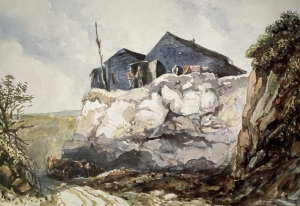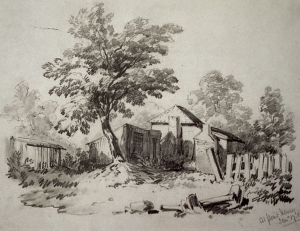
Above: Limeburner’s Point and Point Henry, Geelong.
Early Geelong could be a rough and ready affair. Life was tough at the world’s edge in the far-flung Antipodes.
Location might have been pretty, with its rolling hills and glistening waterfront, but amenity was Third World level. Spurious food and water supplies, rude housing miserably responsive to the elements, rugged bone-rattling transport if you could afford such, an all-pervading stink of ordure, animals and rubbish, unwashed humans, convicts in bayside hulks …
As the fledgling Corio Bay township grew massively with the 1850s Gold Rush, the flood of humanity brought opportunity and greater structure, certainly, but such were the times that the artists and muses of a civilised society, and so prevalent today, were a rarity.
And while affairs current, criminal and civil were recorded and broadly disseminated by the press of the day, the cataloguing of images was all but a non-event. Recording what Geelong looked like at the time was the purview of a very few artists and, later, photographers.
Housed in one the sturdier structures, a two-storey red-brick and sandstone maison, which survives today as a Latrobe Terrace heritage architectural motif, was the Irishman Charles Travers Mackin. An immigrant doctor and gold digger who returned to his medical calling in Geelong, he was also a lynx-eyed artistic chronicler of his new world.


South Geelong. St Andrew’s Church and Manse, Geelong.


Cutting on the beach, Limeburner’s Point. Harris’s, Point Henry.
Mackin’s watercolours are a naïve style, not unlike others of the day such of the many goldfields works by the great S.T. Gill. But they’re much more moody, far less colourful, and often cataloguing urban or rural decay of the time. Many imbue something of an air of poverty to Geelong and its surrounding settlements.
His bush landscapes often seem post-apocalyptic, especially on the goldfields. To be frank, though, the landscape had been obliterated Fromelles-like by voracious gold-hungry diggers and then abandoned. Today’s Victorian bush is still full of dangerous old mineshafts, as any hiker knows full well.
Mackin’s Geelong images are rare and important reminders of the era. The Geelong Gallery mounted an exhibition of his works two decades back, featuring watercolours he painted of early Geelong and district, Ballarat and Bendigo goldfields and other topographical studies in what it called “a rare and engaging record of aspects of Victorian colonial life in the 1850s and 1860s”.


Charles Travers Mackin. At Point Henry.
Research by gallery curator Veronia Filmer revealed Mackin as not just an artist but a highly regarded medical practitioner and public health champion not averse to ruffling a few feathers. She describes his works as naïve and endearing for their stylistic simplicity and honesty. She cites a “spontaneity and freshness” to his oeuvre.
His various works evoked a “sense of delight that Makin experienced as he looked across the bay to Point Henry or viewed the town … from a distance”, she says.
“Mackin was even attracted to the industrial site in Limeburner’s Point where the quarrying and burning of limestone was considered a blight on the landscape. Perhaps it was the incongruous juxtaposition of the pastoral and the industrial that appealed to him.”
Mackin’s brush captures cottages, schools, churches, people, children, livestock, shipping, smoke and that bucolic roughness that characterised Geelong’s earliest enterprises. There’s a starkness to them all, an austerity, that contrasts any romantic notions you might hold about the pioneering days.
Incongruous juxtaposition might have something to do with it but fact is times back then were tough, essentials tight, and Mackin might just have deployed some artistic licence to portray as much. Or maybe he found blue and yellow paint in short supply.
This article appeared in the Geelong Advertiser 15 July 2024.


